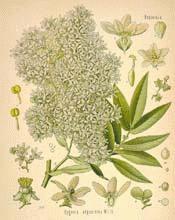
Botanical.com Home Page

|
Kousso
(Hagenia abyssinica WILLD.)
Click on graphic for larger image
|
Kousso
Botanical: Hagenia Abyssinica (WILLD.), Brayera anthelmintica (KUNTH.)
Family: N.O. Rosaceae
---Synonyms---Banksia Abyssinica. Kooso. Kusso. Kosso. Cossoo. Cusso.
---Parts Used---Herb, unripe fruit, and the dried panicles of the pistillate flowers.
---Habitat---North-Eastern Africa, and cultivated in Abyssinia; official in United States of America.
---Description---The tree is named after Dr. K. G. Hagen of K”nigsberg, a German botanist (d. 1829), and also after A. Brayera, a French physician in Constantinople, who wrote a monograph on the tree in 1823. It is a beautiful tree growing about 20 feet high, at an elevation of 3,000 to 8,000 feet. The flowers are unisexual, small, of a greenish colour, becoming purple. The dried flowers have a slight balsamic odour, and the taste is bitter and acrid; the female flowers are chiefly collected, although not exclusively so. 'Loose Kousso,' i.e. flowers stripped from their panicles, sometimes come into the market, often with some staminate flowers among it. These are much less active, easily distin guished by their greeny colour, fertile stamens and outer hairy sepals, whereas the female flowers are a dark reddish colour. As a medicine it is very apt to be adulterated, owing to its high price; therefore it is advisable to buy it in its unpowdered state.
---Constituents---A volatile oil, a bitter acrid resin, tannic acid, and a bitter principle called A Kosin and B Kosin, which is found in Kousso, but thought to be decomposition products. The principle constituent of Kousso is Koso-toxin, a yellow amorphous body, possibly closely allied to filicia acid, and Rottlerin; other inactive colourless bodies are crystalline Protokosin and Kosidin.
---Medicinal Action and Uses---Purgative and anthelmintic; the Abyssinians are greatly troubled with tapeworm, and Kousso is used by them to expel the worms. One dose is said to be effective in destroying both kinds of tapeworms, the taenia solium and bothriocephalus latus; but as it possesses little cathartic power the subsequent administration of a purgative is generally necessary to bring away the destroyed ectozoon. The dose of the flowers when powdered is from 4 to 5 1/2 drachms, macerated in 3 gills of lukewarm water for 15 minutes; the unstrained infusion is taken in two or three doses following each other, freely drinking lemon-juice or tamarind water before and after the doses. It is advisable to fast twenty-four or forty-eight hours before taking the drug. The operation is usually safe, effective, and quick, merely causing sometimes a slight nausea, but it has never failed to expel the worm. Occasionally emesis takes place or diuresis, and collapse follows, but cases of this sort are extremely rare. It is said in Abyssinia that honey gathered from beehives immediately the Kousso plants have flowered is very effective in teaspoonful doses as a taenicide, its effect being to poison the worms.
---Dosage---Infusion of 1/2 oz. to 1 pint of boiling water is taken in 4 oz. doses, and repeated at short intervals. Fluid extract, 2 to 4 drachms.
[Top]
Common Name Index
A MODERN HERBAL Home Page
Bear in mind "A Modern Herbal" was written with the conventional wisdom of the early 1900's. This should be taken into account as some of the information may now be considered inaccurate, or not in accordance with modern medicine.
© Copyright Protected 1995-2025 Botanical.com
|

